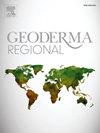Optimizing soil texture spatial prediction in the Brazilian Cerrado: Insights from random forest and spectral data
IF 3.3
2区 农林科学
Q2 SOIL SCIENCE
引用次数: 0
Abstract
Soil texture is crucial for assessing soil quality, crop suitability, and land management. However, precise large-scale soil texture mapping remains challenging. This study integrated a Synthetic Soil Image (SySI) with standard environmental covariates in a digital soil mapping framework to map soil particle size distribution in Brazil's Cerrado biome. Four random forest model arrangements were explored for soil texture modeling. Using an extensive legacy dataset of Cerrado topsoil (0–20 cm), the most accurate model explained approximately 83 % of clay, 86 % of sand, and 74 % of silt variance, with RMSE values of 89 g kg−1 (clay), 102 g kg−1 (sand), and 53 g kg−1 (silt). The findings revealed that elevation and bioclimate have strong predictive capacities, especially when bare soil spectra data are available. Elevation was the only relevant terrain derivative for predicting soil texture. This approach improved model interpretability and provided high-resolution, accurate soil texture maps, aiding users and public policies. Since 65 % of Cerrado soil classes (Ferralsols and Arenosols) do not significantly increase clay content with depth, this work adds value to agricultural soil mapping.
优化巴西塞拉多地区土壤质地空间预测:来自随机森林和光谱数据的见解
土壤质地对评估土壤质量、作物适宜性和土地管理至关重要。然而,精确的大规模土壤纹理映射仍然具有挑战性。该研究将合成土壤图像(SySI)与标准环境协变量集成到数字土壤制图框架中,以绘制巴西塞拉多生物群系的土壤粒度分布。探索了四种随机森林模型排列方式进行土壤纹理建模。使用Cerrado表层土壤(0-20 cm)的大量遗留数据集,最准确的模型解释了大约83%的粘土、86%的沙子和74%的淤泥差异,RMSE值为89 g kg - 1(粘土)、102 g kg - 1(沙子)和53 g kg - 1(淤泥)。结果表明,海拔和生物气候具有较强的预测能力,特别是在有裸地光谱数据的情况下。高程是预测土壤质地的唯一相关地形导数。该方法提高了模型的可解释性,并提供了高分辨率、准确的土壤纹理图,为用户和公共政策提供了帮助。由于塞拉多65%的土壤类别(Ferralsols和Arenosols)并没有随着深度显著增加粘土含量,这项工作为农业土壤制图增加了价值。
本文章由计算机程序翻译,如有差异,请以英文原文为准。
求助全文
约1分钟内获得全文
求助全文
来源期刊

Geoderma Regional
Agricultural and Biological Sciences-Soil Science
CiteScore
6.10
自引率
7.30%
发文量
122
审稿时长
76 days
期刊介绍:
Global issues require studies and solutions on national and regional levels. Geoderma Regional focuses on studies that increase understanding and advance our scientific knowledge of soils in all regions of the world. The journal embraces every aspect of soil science and welcomes reviews of regional progress.
 求助内容:
求助内容: 应助结果提醒方式:
应助结果提醒方式:


